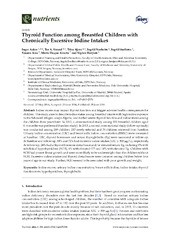Thyroid function among breastfed children with chronically excessive iodine intakes
| dc.contributor.author | Aakre, Inger | en_US |
| dc.contributor.author | Strand, Tor A | en_US |
| dc.contributor.author | Bjøro, Trine | en_US |
| dc.contributor.author | Nordheim, Ingrid | en_US |
| dc.contributor.author | Barikmo, Ingrid | en_US |
| dc.contributor.author | Ares, Susana | en_US |
| dc.contributor.author | Alcorta, Marta Duque | en_US |
| dc.contributor.author | Henjum, Sigrun | en_US |
| dc.date.accessioned | 2017-04-28T13:12:45Z | |
| dc.date.available | 2017-04-28T13:12:45Z | |
| dc.date.issued | 2016-06-28 | |
| dc.Published | Aakre I, Strand TA, Bjøro T, Nordheim I, Barikmo I, Ares, Alcorta, Henjum S. Thyroid function among breastfed children with chronically excessive iodine intakes. Nutrients. 2016;8(7):398 | eng |
| dc.identifier.issn | 2072-6643 | |
| dc.identifier.uri | https://hdl.handle.net/1956/15760 | |
| dc.description.abstract | Iodine excess may impair thyroid function and trigger adverse health consequences for children. This study aims to describe iodine status among breastfed infants with high iodine exposure in the Saharawi refugee camps Algeria, and further assess thyroid function and iodine status among the children three years later. In 2010, a cross-sectional study among 111 breastfed children aged 0–6 months was performed (baseline study). In 2013, a second cross-sectional study (follow-up study) was conducted among 289 children; 213 newly selected and 76 children retrieved from baseline. Urinary iodine concentration (UIC) and breast milk iodine concentration (BMIC) were measured at baseline. UIC, thyroid hormones and serum thyroglobulin (Tg) were measured at follow-up. At baseline and follow-up, 88% and 72% had excessive iodine intakes (UIC ≥ 300 µg/L), respectively. At follow-up, 24% had a thyroid hormone disturbance and/or elevated serum Tg, including 9% with subclinical hypothyroidism (SCH), 4% with elevated fT3 and 14% with elevated Tg. Children with SCH had poorer linear growth and were more likely to be underweight than the children without SCH. Excessive iodine intakes and thyroid disturbances were common among children below four years of age in our study. Further, SCH seemed to be associated with poor growth and weight. | en_US |
| dc.language.iso | eng | eng |
| dc.publisher | MDPI | eng |
| dc.rights | Attribution CC BY | eng |
| dc.rights.uri | http://creativecommons.org/licenses/by/4.0 | eng |
| dc.subject | iodine excess | eng |
| dc.subject | urinary iodine concentration | eng |
| dc.subject | breast milk iodine | eng |
| dc.subject | iodine intake | eng |
| dc.subject | thyroid function tests | eng |
| dc.subject | hypothyroidism | eng |
| dc.subject | thyroglobulin | eng |
| dc.title | Thyroid function among breastfed children with chronically excessive iodine intakes | en_US |
| dc.type | Peer reviewed | |
| dc.type | Journal article | |
| dc.date.updated | 2017-02-08T09:33:22Z | |
| dc.description.version | publishedVersion | en_US |
| dc.rights.holder | Copyright 2016 The Author(s) | |
| dc.identifier.doi | https://doi.org/10.3390/nu8070398 | |
| dc.identifier.cristin | 1375096 | |
| dc.source.journal | Nutrients |

